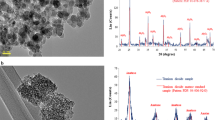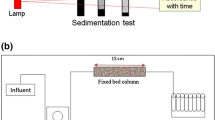Abstract
Facilitation of contaminant transport in porous media due to the effect of indigenous colloidal fine materials has been widely observed in laboratory and field studies. It has been explained by the increase in the apparent solubility of low soluble contaminants as a result of their adsorption on the surface of fine particles. Attachment of colloidal fine particles onto the rock surface could be a promising remedy for this challenge. In this experimental study, the effect of five types of metal oxide nanoparticles, γ-Al2O3, ZnO, CuO, MgO, and SiO2, on suspension transport was investigated. In several core flooding tests, different nanofluids were used to saturate the synthetic porous media. Subsequently, after sufficient soaking time, the suspension was injected into the treated porous media. Analysis of the effluent samples’ concentration by Turbidimeter apparatus demonstrated that the presence of nanoparticles on the rock surface resulted in a significant reduction in fine concentrations in the effluent samples compared with non-treated media; ZnO and γ-Al2O3 demonstrated the best scenarios among the tests performed in this study. In order to characterize the surface properties of the treated porous media, the zeta potential of the surface was measured. Results showed that the treated porous media acts as a strong adsorbent of fine particles, which are the main carrier of contaminants in porous media. These findings were quantitatively confirmed by calculation of the total energy of interaction between the fine particles and rock surface using the Derjaguin–Landau–Verwey–Overbeek theory.






Similar content being viewed by others
Explore related subjects
Discover the latest articles and news from researchers in related subjects, suggested using machine learning.References
Ahmadi M, Habibi A, Pourafshary P, Ayatollahi S (2011) Zeta potential investigation and mathematical modeling of nanoparticles deposited on the rock surface to reduce fine migration. In: Proceedings of the SPE middle east oil and gas show and conference. Society of Petroleum Engineers, Manama, Bahrain, 6–9 March
Amrhein C, Mosher PA, Strong JE (1993) Colloid-assisted transport of trace metals in roadside soils receiving deicing salts. Soil Sci Soc Am J 57(5):1212–1217
Bedrikovetsky P, Siqueira FD, Furtado CA, Souza ALS (2011) Modified particle detachment model for colloidal transport in porous media. Transp Porous Med 86(2):353–383
Bradl HB (2004) Adsorption of heavy metal ions on soils and soils constituents. J Colloid Interface Sci 277(1):1–18
Derjaguin BV, Landau LD (1941) Theory of the stability of strongly charged lyophobic sols and of the adhesion of strongly charged particles in solutions of electrolytes. J Acta Phys Chim 14(6):633–662
Esmaeili Bidhendi M, Karbassi AR, Baghvand A, Saeedi M, Pejman AH (2010) Potential of natural bed soil in adsorption of heavy metals in industrial waste landfill. Int J Environ Sci Tech 7(3):545–552
Faure MH, Sardin M, Vitorge P (1996) Transport of clay particles and radio elements in a salinity gradient: experiments and simulations. J Contam Hydrol 21(1–4):255–267
Grolimund D, Borkovec M (2005) Colloid-facilitated transport of strongly sorbing contaminants in natural porous media: mathematical modeling and laboratory column experiments. Environ Sci Technol 39(17):6378–6386
Grolimund D, Borkovec M, Barmettler K, Sticher H (1996) Colloid-facilitated transport of strongly sorbing contaminants in natural porous media: a laboratory column study. Environ Sci Technol 30(10):3118–3123
Habibi A, Ahmadi M, Pourafshary P, Ayatollahi S (2011) Reduction of fine migration by nanofluids injection, an experimental study. In: Proceedings of the SPE European formation damage conference. Society of Petroleum Engineers, Noordwijk, The Netherlands, 7–10 June
Honeyman BD (1999) Geochemistry: colloidal culprits in contamination. Nature 397:23–24
Huang T, Crews JB, Willingham JR (2008). Nanoparticles for formation fines fixation and improving performance of surfactant structure fluids. In: Proceedings of the IPTC international petroleum technology conference. Society of Petroleum Engineers, Kuala Lumpur, Malaysia, 3–5 Dec
Huang T, Evans BA, Crews JB, Belcher CK (2010) Field case study on formation fines control with nanoparticles in offshore applications. In: Proceedings of the SPE annual technical conference and exhibition. Society of Petroleum Engineers, Florence, Italy 19–22 Sept
Israelachvili JN (2011) Intermolecular and surface forces, 3rd edn. Elsevier Inc., California
Kersting AB, Efurd DW, Finnegan DL, Rokop DJ, Smith DK (1999) Migration of plutonium in ground water at the Nevada Test Site. Nature 397:56–59
Khilar KC, Fogler HS (1998) Migrations of fines in porous media. Kluwer Academic Publishers, Dordrecht
Kletzke S, Lang F, Kaupenjohawn M (2002). Colloids and colloid-facilitated transport of contaminants in soils and sediments. In: Wollesen de Jong Lis, Moldrup Ple, Horbye Jacobsen Ple (eds) In: Proceedings from an international workshop on colloids at Research Centre Foulum, Tjele, Denmark 19–20 Sept. DIAS report, Plant Production, no. 80
Kretzschmar R, Borkovec M, Grolimund D, Elimelech M (1999) Mobile subsurface colloids and their role in contaminant transport. Adv Agron 66:121–193
Lee GF, Jones LA (1993) Groundwater pollution by municipal landfills: leachate composition, detection and water quality significance. In: Proceedings of Sardinia’ 93 IV International Landfill Symposium, Sardinia, Italy, 1093–1103
Malkovsky VI, Pek AA (2008) Effect of elevated velocity of particles in groundwater flow and its role in colloid-facilitated transport of radionuclides in underground medium. Transp Porous Med 78:277–294
Marseguerra M, Patelli E, Zio E (2001) Groundwater contaminant transport in presence of colloids II: sensitivity and uncertainty analysis on literature case studies. Ann Nucl Energy 28(18):1799–1807
McCarthy JF, McKay LD (2004) Colloid transport in the subsurface: past, present, and future challenges. Vadose Zone J 3(2):326–337
McCarthy JF, Zachara JM (1989) Subsurface transport of contaminants. Environ Sci Technol 23(5):496–502
Morales VL (2011) Facilitated transport of groundwater contaminants in the vadose zone: colloids and preferential flow paths. Ph.D. Dissertation, Cornell University, USA
Noell AL, Thomson JL, Corapcioglu MY, Triay IR (1998) The role of silica colloids on facilitated cesium transport through glass bead columns and modeling. J Contam Hydrol 31(1–2):23–56
Nouri J, Mahvi AH, Jahed GR, Babaei AA (2008) Regional distribution pattern of groundwater heavy metals resulting from agricultural activities. Environ Geol 55(6):1337–1343
Ogolo N, Olafuyi O, Onyekonwu M (2012) Effect of nanoparticles on migrating fines in formations. In: Proceedings of the SPE international oilfield nanotechnology conference. Society of Petroleum Engineers, Noordwijk, The Netherlands, 12–14 June
O’Neill ME (1968) A sphere in contact with a plane wall in a slow linear shear flow. J Chem Eng Sci 23(11):1293–1298
Pourafshary P, Azimpour SS, Motamedi P, Samet M, Taheri SA, Bargozin H, Hendi SS (2009) Priority assessment of investment in development of nanotechnology in upstream petroleum industry. In: Proceedings of the SPE Saudi Arabia section technical symposium. Society of Petroleum Engineers, AlKhobar, Saudi Arabia, 9–11 May
Rahbar M, Ayatollahi S, Ghatee MH (2010) The roles of nano-scale intermolecular forces on the film stability during wettability alteration process of the oil reservoir rocks. In: Proceedings of the SPE Trinidad and Tobago energy resources conference. Society of Petroleum Engineers, Port-of-Spain, Trinidad and Tobago, 27–30 June
Richards BK, McCarthy JF, Steenhuis TS, Hay AG, Zevi Y, Dathe A (2007) Colloidal transport: the facilitated movement of contaminants into groundwater (FEATURE). J Soil Water Conserv 62(3):55A–56A
Rodriquez E, Roberts MR, Yu H, Huh C, Brayant SL (2009) Enhanced migration of surface-treated nanoparticles in sedimentary rocks. In: Proceedings of the SPE annual technical conference and exhibition. Sociery of Petroleum Engineers, New Orleans, USA, 4–7 Oct
Roy SB, Dzombak DA (1996) Colloid release and transport processes in natural and model porous media. Colloids Surf A Physicochem Eng Asp 107:245–262
Saiers JE (2002) Laboratory observations and mathematical modeling of colloid-facilitated contaminant transport in chemically heterogeneous systems. Water Resour Res 38(4):1032–1044
Sen TK (2001) Studies on colloidal fines-associated contaminant transport in porous media. Dissertation, Indian Institute of Technology
Sen TK, Khilar KC (2006) Review on subsurface colloids and colloid-associated contaminant transport in saturated porous media. Adv Colloid Interface Sci 119(2):71–96
Sen TK, Mahajan SP, Khilar KC (2002a) Adsorption of Cu2+ and Ni2+ on iron oxide and kaolin and its importance on Ni2+ transport in porous media. Colloids Surf A Physicochem Eng Asp 211(1):91–102
Sen TK, Mahajan SP, Khilar KC (2002b) Colloid-associated contaminant transport in porous media: 1. Experimental studies. AIChE J 48(10):2366–2374
Simunek J, He C, Pang L, Bradford SA (2006) Colloid-facilitated solute transport in variably saturated porous media: numerical model and experimental verification. Vadose Zone J 5:1035–1047
Sojitra L, Valsaraj KT, Reible DD, Thibodeaux LJ (1995) Transport of hydrophobic organics by colloids through porous media 1. Experimental results. Colloids Surf A Physicochem Eng Asp 94(2–3):197–211
Sun H, Gao B, Tian Y, Yin X, Yu C, Wang Y, Ma L (2010) Kaolinite and lead in saturated porous media: facilitated and impeded transport. J Environ Eng 136(11):1305–1308
Torok J, Buckley LP, Woods BL (1990) The separation of radionuclide migration by solution and particle transport in soil. J Contam Hydrol 6(2):185–203
Verwey EJW, Overbeek JTG (1948) Theory of the stability of lyophobic colloids. Elsevier Inc., New York
Wang D, Paradelo M, Bradford SA, Peijnenburg WJGM, Chu L, Zhou D (2011) Facilitated transport of Cu with hydroxyapatite nanoparticles in saturated sand: effects of solution ionic strength and composition. Water Res 45(18):5905–5915
Xie J, Wang X, Lu J, Zhou X, Lin J, Li M, Xu Q, Du L, Liu Y, Zhou G (2013) Colloid-associated plutonium transport in the vadose zone sediments at Lop Nor. J Environ Radioact 116:76–83
Yin X, Gao B, Ma LQ, Saha UK, Sun H, Wang G (2010) Colloid-facilitated Pb transport in two shooting-range soils in Florida. J Hazard Mater 177(1–3):620–625
Zhang T, Davidson A, Bryant S, Huh C (2010) Nanoparticle-stabilized emulsion for application in enhanced oil recovery. In: Proceedings of the SPE improves oil recovery symposium. Society of Petroleum Engineers, Tulsa, Oklahoma, USA, 24–28 April
Acknowledgments
The authors acknowledge financial and scientific support provided by the Faculty of petroleum engineering at the Institute of Petroleum Engineering (IPE), University of Tehran.
Author information
Authors and Affiliations
Corresponding author
Electronic supplementary material
Below is the link to the electronic supplementary material.
Rights and permissions
About this article
Cite this article
Arab, D., Pourafshary, P., Ayatollahi, S. et al. Remediation of colloid-facilitated contaminant transport in saturated porous media treated by nanoparticles. Int. J. Environ. Sci. Technol. 11, 207–216 (2014). https://doi.org/10.1007/s13762-013-0311-3
Received:
Revised:
Accepted:
Published:
Issue Date:
DOI: https://doi.org/10.1007/s13762-013-0311-3




